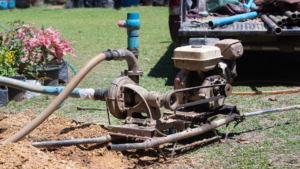Water doesn’t just show up inside walls or under floors for no reason. If there’s a puddle in the hallway, a strange stain on the ceiling, or your carpet feels oddly damp, there’s usually one answer: a leak. But finding the actual spot where the water’s coming from? That’s a whole other problem. Luckily, it’s not always about ripping up half your house to figure it out.
These days, plumbers and leak detection pros use smart tools that can help them track down water without smashing through walls. It’s actually pretty cool how it all works, and it can save homeowners a ton of stress, time, and money.
Where Does the Water Even Come From?
A lot of leaks start in places most people never see. Pipes run through walls, under the floor, even above the ceiling. Over time, these pipes can get worn out, corroded, or knocked around. Joints can loosen. Tree roots can sneak into underground lines. And then—boom—a slow, sneaky leak starts.
What makes it tricky is that water doesn’t always stay put. It can run along beams, drip down wires, or soak into insulation. By the time you notice a spot on the wall or a puddle on the floor, the actual leak might be meters away.
That’s why finding the real source can be such a pain. But thanks to some awesome tools and techniques, experts can find leaks faster and more accurately than ever.
How Professionals Find Hidden Leaks
If you ever think there’s a leak but can’t figure out where it’s coming from, the best thing to do is call a professional. And no, they won’t just walk in swinging a hammer. Most start with tools that don’t damage anything.
One good example is using acoustic listening devices. These tools help plumbers “hear” leaks inside walls or underground. Water makes noise when it escapes from a pipe—kind of a hissing or dripping sound—and this equipment picks it up, even through concrete.
They might also use thermal imaging cameras. These cameras show the temperature of different surfaces, so if there’s a cold patch behind a wall where water is leaking, the camera spots it. Pretty smart, right?
In some cases, they even use gas testing, where a safe gas is pushed into the pipes. If it escapes anywhere, sensors can detect it above ground. That’s especially handy for leaks under concrete floors or in big yards.
For people living in Western Australia, there’s a team that specializes in this stuff. If you ever need pros with top tools and solid experience, Leak Detection Perth is a reliable option that can help without wrecking your home just to find the problem.
Why It’s Important to Act Fast
Leaks might seem small at first—just a drip or a damp patch. But leaving it alone can turn into a big mess. Water can rot wood, grow mould, and mess up electrical wiring. Even tiny leaks can waste loads of water over time, which makes the water bill shoot up without warning.
And when damage builds up slowly, insurance companies might not cover the cost. They usually expect homeowners to catch problems early. So waiting too long can mean paying for everything out of pocket.
It’s not just about damage, either. Mould from water leaks can make people sick. It spreads in walls and ceilings, especially in warm or damp spots. Breathing it in too long can cause coughing, sneezing, or even worse problems for people with asthma or allergies.
Common Signs There’s a Leak You Can’t See
There are some weird little clues that might mean water is leaking somewhere behind the scenes. Here’s what to watch for:
- A musty smell, especially near walls or floors
- Paint bubbling or peeling for no reason
- Mould spots on the ceiling or behind furniture
- Warm or cold patches underfoot (if pipes are under the floor)
- Higher water bills even if you’re not using more water
- Water meter running even when everything is turned off
Sometimes people notice their water heater turns on more often or that the floor in the bathroom feels soft or squishy. All of those could be warning signs.
Finding Leaks Outside the House
Not all leaks happen indoors. Some are outside, under the yard or driveway. These are usually even harder to spot because they don’t always show any signs above ground—at least not right away.
One thing people might notice is a patch of grass that’s way greener than the rest. Or maybe there’s a soggy spot in the yard that never dries. These might seem harmless, but underground water leaks can weaken soil and even mess with the foundation of a house if left alone too long.
That’s why outdoor leak detection is just as important as checking inside. Plumbers use special microphones, sensors, and even mini-cameras they send through pipes to find the exact spot without digging up the whole yard.
Can You Prevent Leaks Before They Start?
Totally. While no one can control every little thing, there are some easy ways to lower the chance of serious leaks.
- Don’t ignore strange signs. Dampness, stains, or even small drips usually mean something’s off.
- Know where your water shut-off valve is. If a pipe bursts, turning it off fast can stop a flood.
- Keep an eye on your water meter. If it moves when no water is running, something’s leaking.
- Get older pipes checked. If your house is over 20 years old, a plumbing check-up can catch problems before they show up in a big way.
- Avoid flushing or pouring stuff down the drain that doesn’t belong. Things like wipes, grease, or hair can cause clogs and pipe damage over time.
Some people also install smart water monitors that track flow and alert you to leaks early. It’s not a must-have, but for busy homes or older buildings, it can be super helpful.
What to Take Away From All This
Leaks don’t have to turn into disasters. With the right tools and a little awareness, they can be found and fixed without tearing your house apart. Knowing the signs, acting early, and calling in the right help makes all the difference.
Water might be sneaky, but it’s not unstoppable. Whether it’s hiding behind the bathroom wall or running under the garden, there’s always a way to track it down and stop it from doing damage. And most of the time, it doesn’t even take a single hammer swing to get the job done.
So if something feels off—if the wall smells weird, if your floor feels damp, or your water bill just doesn’t make sense—it’s worth checking. A fast fix now is way better than a massive repair later.
And honestly, keeping your home dry and damage-free? That just feels better.




